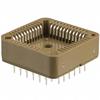The current trend of technology has brought parallel machines equipped with multiple processors and multiple memory sockets to be available off-the-shelf -- or via renting through Iaas Clouds -- at reasonable costs. This has opened the possibility of natively supporting HPC in diffused realities, like industry or academic labs. At the same time, the Parallel Discrete Event Simulation (PDES) area has given rise to attractive simulation engines, designed with orientation to high performance and scalability, also targeting differentiated exploitation of the specific support offered by the underlying hardware. In this article, we present an experimental study where we deploy two last-generation open-source PDES platforms -- one optimistic (USE) and one conservative (PARSIR) -- on top of two significantly different hardware chipsets based on either {\sf x86} CISC or {\sf powerPC} RISC technology, both offering multiple Non-Uniform-Memory-Access (NUMA) nodes and multiple tens of cores and hardware-threads (logical CPUs). Also, we consider real-world simulation models configured in a variety of different manners in order to investigate the actual execution profile of the PDES engines on the two distinct hardware platforms. Our objective is the one of providing insights on current performance trends, which can support decisions in terms of both strategies -- for software platforms to adopt -- and investments -- in terms of hardware platforms -- in the area of discrete event simulation.
翻译:暂无翻译




